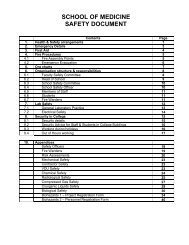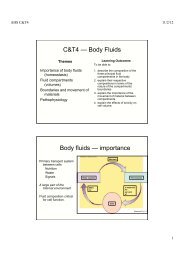Endocrine System
Endocrine System
Endocrine System
Create successful ePaper yourself
Turn your PDF publications into a flip-book with our unique Google optimized e-Paper software.
<strong>Endocrine</strong> <strong>System</strong><br />
Lecture # 1<br />
Prof Kumlesh K. Dev<br />
Department of Physiology<br />
Chapter 4 Principles of Neural and Hormonal Communication<br />
Human Physiology by Lauralee Sherwood ©2007 Brooks/Cole-Thomson Learning<br />
<strong>Endocrine</strong> Lectures<br />
Thu 16th Apr 10-11 hr Hormones<br />
– basics on hormone signaling<br />
Fri 17th Apr 14-15 hr Hormones II<br />
– hypothalamus, pituitary, adrenal glands<br />
Mon 20th Apr 09-10 hr Cancelled<br />
– no lecture<br />
Thu 23rd Apr 10-11 hr Hormones III<br />
– thyroid, parathyroid, pineal glands<br />
Chapter 4 Principles of Neural and Hormonal Communication<br />
Human Physiology by Lauralee Sherwood ©2007 Brooks/Cole-Thomson Learning<br />
1
Types of cellular communication<br />
Classification<br />
Communication is critical for cell survival<br />
2 major regulatory systems:<br />
– Nervous <strong>System</strong><br />
– <strong>Endocrine</strong> <strong>System</strong><br />
Chapter 4 Principles of Neural and Hormonal Communication<br />
Human Physiology by Lauralee Sherwood ©2007 Brooks/Cole-Thomson Learning<br />
Four types of chemical messengers<br />
Classification<br />
1) Autocrine/Paracrine<br />
• Local chemical messengers<br />
• Exert effect on neighbouring cells (paracrine)<br />
or on same cell (autocrine)<br />
2) Neurotransmitter<br />
• Short-range chemical messengers<br />
• Diffuse across narrow space (synapse) to act<br />
on adjoining target cell (another neuron, a<br />
muscle, or a gland)<br />
2
Four types of chemical messengers<br />
Classification<br />
3) Neurohormones<br />
• Hormones released into blood by<br />
neurosecretory neurons<br />
• Distributed through blood to distant target cells<br />
4) Hormones<br />
• Long-range messengers<br />
• Secreted into blood by endocrine glands in<br />
response to appropriate signal and act on<br />
distant target cells<br />
1. Autocrine/Paracrine<br />
Classification<br />
– chemical messenger<br />
released from a cell :<br />
Secretory Cell<br />
– can act on itself<br />
(autocrine)<br />
– can act on another cell<br />
close-by (paracrine)<br />
Cell #2<br />
3
2. Neurotransmitters<br />
Classification<br />
– Neurotransmitters<br />
released from<br />
synaptic vesicles<br />
– Diffuse across<br />
synapse between two<br />
cells<br />
– Transmitter binds a<br />
receptor<br />
– Receptor activation<br />
stimulates the cell<br />
synapse<br />
with<br />
another<br />
neuron<br />
synapse<br />
with<br />
muscles<br />
synapse<br />
with<br />
glands<br />
3. Neurohormones<br />
Classification<br />
– Released from<br />
synaptic vesicles<br />
by neuron<br />
– Released into<br />
blood<br />
– Acts in manner<br />
similar to hormones<br />
4
4. Hormones<br />
Classification<br />
– Messengers of<br />
endocrine system<br />
– Released from<br />
endocrine gland into<br />
blood<br />
– Transported in blood<br />
– Target cell:expresses<br />
specific receptors<br />
Nervous and <strong>Endocrine</strong> <strong>System</strong>s<br />
Classification<br />
Property Nervous <strong>System</strong> <strong>Endocrine</strong> <strong>System</strong><br />
Structure Wired system of neurons Wireless system of glands<br />
Chemical Messenger Neurotransmitter<br />
Hormones<br />
Target site Very close Far away<br />
Distance of Action Across synaptic cleft Carried by blood<br />
Speed of Response milliseconds mins to hours<br />
Duration of Action milliseconds mins to days<br />
Major Function fast precise responses long duration responses<br />
5
Neuroendocrine cells<br />
Classification<br />
Neuroendocrine cells release neurohormones<br />
and are found in, for example:<br />
• adrenal medulla<br />
• thyroid<br />
• islet of Langerhangs<br />
• pituitary cells<br />
• renin-secreting cells<br />
• mucosa of the gastro-intestinal tract<br />
• pancreas<br />
• lower respiratory tract<br />
Types of hormone<br />
Classification<br />
• Two hormone categories based on solubility<br />
– Hydrophilic (lipophobic, water soluble)<br />
• Peptide hormones<br />
• Catecholamines<br />
– Lipophilic (hydrophobic, water insoluble)<br />
• Thyroid hormone<br />
• Steroid hormones<br />
6
Types of hormone<br />
Classification<br />
Property Peptide Catecholamines Thyroid Steriods<br />
Structure amino acids tyrosine iodinated cholesterol<br />
derivative tyrosine derivative<br />
Solubility hydrophilic hydrophilic lipophilic lipophilic<br />
lipophobic lipophobic hydrophobic hydrophobic<br />
Synthesis in ER in cytosol organelles intracell<br />
Storage granules granules colloid lipd droplets<br />
Secretion exocytosis exocytosis endocytosis diffusion<br />
of granules of granules of colloid<br />
Blood free hormone plasma bound plasma bound plasma bound<br />
Transport<br />
Receptors on cell surface on cell surface inside cell inside cell<br />
Hormone hypothalamic, adrenal medulla thyroid adrenal cortex<br />
pituitary, pineal, follicular gonads, Vit D<br />
pancreas,<br />
parathyroid, GIT,<br />
kidney, liver, heart<br />
Steroid hormone<br />
Synthesis<br />
female sex<br />
hormone<br />
male sex<br />
hormone<br />
adrenal cortex<br />
hormone<br />
adrenal cortex<br />
hormone<br />
- steroid hormones derived from cholesterol<br />
- are small lipid-soluble molecules<br />
- diffuse throw cell membrane<br />
- receptor is intracellular<br />
female sex<br />
hormone<br />
7
Steroid hormone<br />
Synthesis<br />
All steroid hormones are produced via cholesterol modification<br />
Extracellular Receptors<br />
Receptors<br />
• all cells maybe exposed to<br />
hormones via circulation<br />
• only cells with receptors<br />
for hormone can respond<br />
• extracellular chemical<br />
(hormone) binds to<br />
receptor<br />
enzyme<br />
ion channel<br />
change in<br />
ion flow<br />
(e.g. Na,<br />
Ca, K, Cl)<br />
• receptor activation alters<br />
– channel function<br />
– second-messenger<br />
systems<br />
Increased<br />
product signal<br />
(eg cAMP)<br />
8
Intracellular/Nuclear Receptors<br />
Receptors<br />
• steroid receptors bind<br />
steroid hormone<br />
• hormone-receptor complex<br />
becomes a transcription<br />
factor (alters gene<br />
transcription)<br />
• each steroid receptor binds<br />
a unique DNA sequence<br />
(response element within<br />
an enhancer region)<br />
• this alters the rate of<br />
transcription<br />
plasma<br />
protein<br />
carrier<br />
oestrogen<br />
oestrogen receptor<br />
translocation<br />
protein<br />
synthesis<br />
mRNA<br />
transcription<br />
Receptor Regulation<br />
• target cell may be unresponsive due to lack of<br />
receptors (physiological, genetic, disease)<br />
Receptors<br />
• one hormone can influence activity of another hormone<br />
by regulation of its receptor:<br />
Permissiveness<br />
– one hormone is required for another hormone to work<br />
Synergism<br />
– actions of several hormones are complimentary<br />
– combined effect is greater than sum of separate effects<br />
Antagonism<br />
– one hormone inhibits another hormone’s receptors<br />
– reduces effectiveness of second hormone<br />
9
Steroid hormone receptors<br />
Receptors<br />
• Type I receptors<br />
– Sex hormone receptors<br />
• Androgen receptor<br />
• Estrogen receptor<br />
• Progesterone receptor<br />
– Glucocorticoid receptor<br />
– Mineralocorticoid receptor<br />
• Type II receptors (No HSP association)<br />
– Vitamin A receptor (vitamin A)<br />
– Vitamin D receptor (vitamin D)<br />
– Retinoid receptor<br />
– Thyroid hormone receptor<br />
Types of <strong>Endocrine</strong> Glands<br />
<strong>Endocrine</strong> <strong>System</strong><br />
– Derived from<br />
epithelial tissue<br />
– Primary endocrine<br />
organs<br />
– Secondary<br />
endocrine organs<br />
10
Primary & Secondary <strong>Endocrine</strong> Glands<br />
<strong>Endocrine</strong> <strong>System</strong><br />
endocrine glands are composed<br />
of clumps of secretory cells of<br />
epithelial origin<br />
surrounded by capillaries<br />
(fenestrated)<br />
unlike exocrine glands, endocrine<br />
glands have no duct system<br />
endocrine glands may exist in<br />
discrete organs - pituitary, thyroid,<br />
parathyroid, adrenal and pineal<br />
glands<br />
ENDOCRINE SECRETION<br />
AS PRIMARY FUNCTION<br />
- Pituitary gland<br />
- Adrenal glands<br />
- Thyroid gland<br />
- Parathyroid glands<br />
- Pineal gland<br />
• Hypothalamus<br />
• Thymus<br />
• Pancreas<br />
• Gonads<br />
• Kidney<br />
• Heart<br />
• Adipose tissue<br />
<strong>Endocrine</strong> <strong>System</strong><br />
<strong>Endocrine</strong> <strong>System</strong><br />
Overall functions<br />
– regulate organic metabolism<br />
– controls water and electrolyte balance<br />
– induces adaptive changes to help cope with<br />
stress<br />
– promotes smooth, growth and development<br />
– controls reproduction<br />
– regulates red blood cell production<br />
– controls circulation, digestion, absorption of food<br />
11
Hormone Signalling<br />
<strong>Endocrine</strong> <strong>System</strong><br />
Hormones secreted by endocrine gland cells<br />
• enter blood and distributed throughout body<br />
• can act at distant target sites<br />
Hormone secretion by endocrine glands triggered by<br />
many signals:<br />
• Insulin secretion regulated by blood glucose conc<br />
• Secretion of sex hormones from ovaries and testes<br />
controlled by anterior pituitary hormones<br />
• Oxytocin secretion from posterior pituitary<br />
regulated by neurotransmitter release<br />
Hormone Concentrations<br />
<strong>Endocrine</strong> <strong>System</strong><br />
• plasma conc. of hormones is controlled by rate of<br />
secretion<br />
• secretory output of endocrine cells controlled by<br />
– neural input<br />
– another hormone<br />
• plasma conc. also influenced by<br />
– rate of removal from blood by metabolism and<br />
excretion<br />
– rate of activation or its extent of binding to<br />
plasma proteins<br />
12
<strong>Endocrine</strong> Dysfunction: Hyposecretion<br />
Primary hyposecretion<br />
• due to abnormality within gland<br />
• causes<br />
– genetic<br />
– dietary (eg lack of iodine)<br />
– chemical or toxic<br />
– immunologic (autoimmune diseases)<br />
– cancer<br />
– Iatrogenic (eg surgical removal)<br />
– idiopathic (unknown)<br />
Secondary hyposecretion<br />
• deficiency of tropic hormone<br />
<strong>Endocrine</strong> <strong>System</strong><br />
<strong>Endocrine</strong> Dysfunction: Hypersecretion<br />
<strong>Endocrine</strong> <strong>System</strong><br />
• Causes<br />
– Tumours continuously secrete hormone<br />
– Immunologic factors<br />
• Primary hypersecretion<br />
– too much hormone secreted due to<br />
abnormality within gland<br />
• Secondary hypersecretion<br />
– excessive stimulation of gland causes<br />
oversecretion<br />
13
Tropic Hormones<br />
<strong>Endocrine</strong> <strong>System</strong><br />
• regulates secretion of other hormones<br />
• stimulates/maintains endocrine target tissues<br />
• example<br />
– Thyroid-stimulating hormone (TSH)<br />
– secreted from anterior pituitary<br />
– stimulates thyroid hormone secretion from<br />
thyroid gland<br />
– maintains structural integrity of thyroid gland<br />
Control by Feedback Mechanisms<br />
<strong>Endocrine</strong> <strong>System</strong><br />
Positive Feedback<br />
e.g. Hormone 3 activates<br />
Gland 2<br />
Gland 1<br />
Hormone 1<br />
Gland 2<br />
-<br />
+<br />
Negative Feedback<br />
e.g. Hormone 3 inhibits<br />
Gland 1<br />
Hormone 2<br />
Gland 3<br />
Hormone 3<br />
14

















